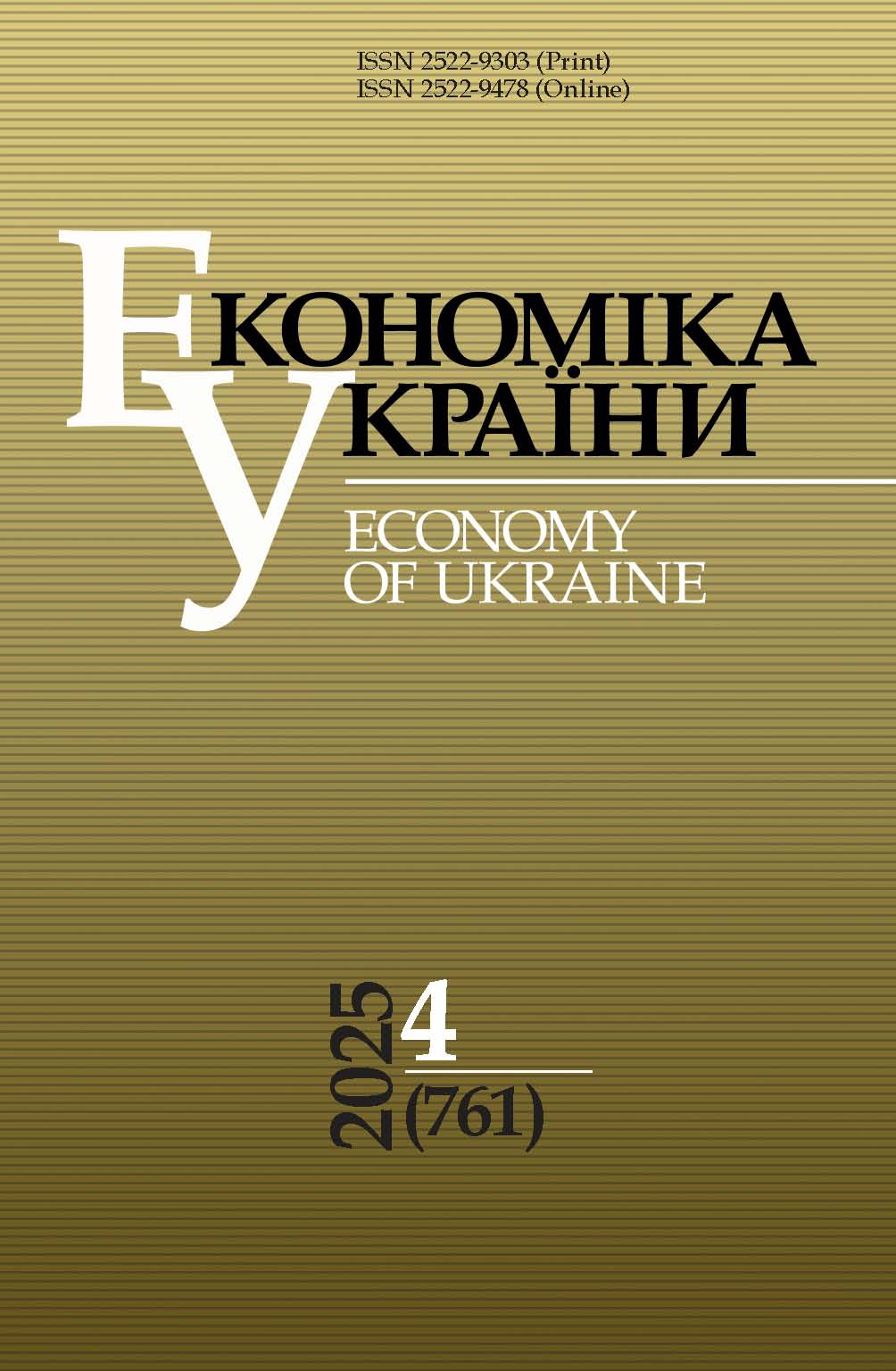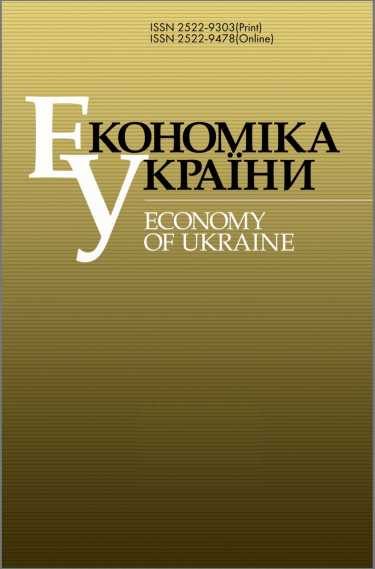ІНСТИТУЦІОНАЛІЗАЦІЯ РОЗВИТКУ СИСТЕМИ ДЕРЖАВНОГО РЕГУЛЮВАННЯ ПІДПРИЄМНИЦЬКОЇ ДІЯЛЬНОСТІ В АГРАРНОМУ СЕКТОРІ УКРАЇНИ: СУПЕРЕЧНОСТІ ТА СПОСОБИ ЇХ НЕЙТРАЛІЗАЦІЇ
DOI:
https://doi.org/10.15407/economyukr.2025.04.050Ключові слова:
підприємницька діяльність; державне регулювання; непослідовності; аграрний сектор економіки; конкуренція; євроінтеграціяАнотація
Обґрунтовано об’єктивну, пов’язану з особливостями сільського господарства необхідність державного регулювання підприємницької діяльності в аграрному секторі, яке має спрямовуватися на обмеження дії ринкових механізмів з метою врівноваження економічних, екологічних і соціальних функцій галузі. Виокремлено етапи ринкових трансформацій у аграрному секторі, проаналізовано процеси формування підприємницького середовища в ринкових умовах. Систематизовано непослідовності, суперечності, прогалини державної аграрної регуляторної політики, здійснено аналіз їх негативних впливів на забезпечення продовольчої безпеки і продовольчого суверенітету України, збереження продуктивності природного ресурсу аграрного сектору для потреб нинішнього і майбутнього поколінь, осілості сільського населення і розвитку сільських територій.
На основі аналізу розвитку підприємництва в умовах ринкових трансформацій у аграрному секторі визначено відмінності цих трьох етапів. Акцентовано на поступовому згортанні державного впливу на формування сприятливого для розширення підприємницької діяльності фінансово-кредитного, податкового, інфраструктурного середовища; відсутності системної довгострокової регуляторної політики, спрямованої на становлення в країні індивідуального і корпоративного фермерського типу господарювання й розвиток кооперативного руху. Відсутність політики впливу на диверсифікацію виробництва продовольчої продукції і підтримки вузької спеціалізації великих підприємств з ознаками монокультури обумовила згортання виробництва тваринницького та інших трудомістких виробництв, збіднення асортименту продовольчої продукції, катастрофічне зниження зайнятості й посилення міграції сільського населення, знелюднення сільських поселень.
З огляду на результати дослідження сформульовано основи вдосконалення державної регуляторної політики підтримки розвитку підприємницької діяльності, спрямованої на економіко-соціо-екологічно збалансований розвиток аграрного сектору з урахуванням його реального стану і вимог щодо її наближення в євроінтеграційному процесі до Спільної аграрної політики ЄС.
Посилання
Smith, A. (1998). An Inquiry into the Nature and Causes of the Wealth of Nations: A Selected Edition. Oxford, Oxford University Press. 618 p.
Schumpeter, J. (2011). The Theory of Economic Development. An Inquiry into Profits, Capital, Credit, Interest, and the Business Cycle. Kyiv. 242 p. [in Ukrainian].
McConnell, C., Brue, S., Flynn, S. (2009). Economics: principles, problems, and policies. 18th ed. McGraw-Hill Irwin. 996 р. URL: https://library.nlu.edu.ua/POLN_TEXT/SENMK/economics_mcconnell.pdf
Nepochatenko, O. (2007). Organizational and economic mechanisms of lending to agricultural enterprises. Uman. 456 p. [in Ukrainian].
Zavadskyi, Y. (1992). Agricultural production management in the agro-industrial complex system. Kyiv. 367 p. [in Ukrainian].
Mohylnyi, O. (2002). State regulation of agricultural production during the period of economic transformation. Kyiv. 420 p. [in Ukrainian].
Hadzalo, Ya., Zhuk, V. (2015). Scientific foundations of the development of agrarian entrepreneurship and rural areas according to the country-preserving model. Kyiv. 40 p. URL: https://magazine.faaf.org.ua/images/stories/juk/dopovid_2015_selo/dopovid_NAAN_2015.pdf [in Ukrainian].
Lupenko, Yu., Malik, M., Shpykuliak, O. (2023). Entrepreneurial activity in the agricultural sector of the economy. Kyiv. 208 p. https://doi.org/10.5281/zenodo.10026711 [in Ukrainian].
Ivanchenko, V. (2020). Sustainable development of entrepreneurship in agriculture: theory, methodology, practice. Kharkiv. 379 p. [in Ukrainian].
Ilchuk, M., Tomashevska, O., Ivanov, Ye., Vodnitskyi, M., Marchuk, V. (2024). Development of business activities in the agricultural sector of Ukraine's economy. Agrosvit. No. 9. P. 57-63. https://doi.org/10.32702/2306-6792.2024.9.57 [in Ukrainian].
Kovbasa, O. (2024). Development of entrepreneurial activity in the agricultural sector of the Ukrainian economy. Economy and Society, (62). https://doi.org/10.32782/2524-0072/2024-62-69 [in Ukrainian].
Sychova, R., Shevchenko, N. (2010). Features of entrepreneurship development in the agricultural sector of the region. Ekonomika APK. No. 13. P. 2-4 [in Ukrainian].
Pohrishchuk, B., Melnyk, V., Dobizha, N. (2023). Entrepreneurial potential of agricultural development. Academy Review. No. 2 (59). P. 65-74. https://doi.org/10.32342/2074-5354-2023-2-59-4 [in Ukrainian].
Onyshchenko, O. (2001). Completion of the initial stage of forming a new organizational structure of the agricultural sector. Economy of Ukraine. No. 7. P. 59-68 [in Ukrainian].
Romanova, L. (1997). The emergence of entrepreneurship in agriculture. Kyiv. 272 p. [in Ukrainian].
Yavorska, T. (2012). Small business in agriculture: theory and practice. Kyiv. 386 p. [in Ukrainian].
Shpykuliak, O., Pugachov, M., Hryschenko, O., Ksenofontova, K. (2023). Assessment of the Effectiveness of Development of Agrarian Entrepreneurship in Modern Economic Conditions: Aspects of Wartime and Post-War Recovery. Modern Economics. No. 41. P. 170-178. https://doi.org/10.31521/modecon.V41(2023)-24 [in Ukrainian].
Volska, O. (2020). Current problems of regulation of agrarian sector of the state economy. Taurida Scientific Herald. Series: Economics. Vol. І. P. 17-25. URL: http://tnv-econom.ksauniv.ks.ua/index.php/journal/article/view/3/2 [in Ukrainian].
Hryhorenko, Ya. (2016). Features of state regulation of the agrarian sector in the context of ensuring economic security of the state. Ekonomika APK. No. 7. P. 100-105. URL: https://eapk.com.ua/web/uploads/pdf/Vol.%2023,%20No.%207,%202016_apk-100-106.pdf [in Ukrainian].
Haydutskyi, P. (2020). The truth about the land market. Kyiv. 58 p. [in Ukrainian].
Kulynych, P. (2011). Legal problems of protection and use of agricultural lands in Ukraine. Kyiv. 688 p. [in Ukrainian].
Zinovchuk, V. (2001). Methodological principles of the formation of the cooperative movement in Ukraine. In: National Cooperative Movement and Structural Changes in the Economy of Ukraine in the 21st Century. Collection of Scientific Papers of Conference Participants. Kyiv. P. 238-243 [in Ukrainian].
Honcharenko, V. (2001). Problems and prospects of the formation of the cooperative sector in the financial and credit system of Ukraine. In: National Cooperative Movement and Structural Changes in the Economy of Ukraine in the 21st Century. Collection of Scientific Papers of Conference Participants. Kyiv. P. 327-333 [in Ukrainian].
Moldavan, L. (2022). Cooperatives in sustainable agricultural and rural development. In: What is the future of agricultural cooperatives? V. Zinovchuk (Ed.). Zhytomyr. 275 p. P. 10-57. URL: https://www.researchgate.net/publication/365964497_Naslidki_neposlidovnosti_derzavnoi_politiki_u_sferi_silskogospodarskoi_kooperacii_v_Ukraini_Ake_majbutne_silskogospodarskih_kooperativiv_kol_monografia_za_red_V_Zinovcuka_-_Zitomir_Poliskij_nacionalni [in Ukrainian].
Medvedev, V. (2015). Land reform and fertility of soil. Bulletin of Agricultural Science. No. 5. P. 73-79. URL: https://agrovisnyk.com/pdf/ua_2015_05_17.pdf [in Ukrainian].
Balayev, A., Pinchuk, M. (2020). Soil condition and measures to restore its fertility. 38 p. URL: https://nenc.gov.ua/wp-content/uploads/2020/10/Стан-грунтiв_2020.pdf [in Ukrainian].
Furdychko, O. (2009). Scientific foundations of rehabilitation of disturbed agricultural landscapes of Ukraine. Bulletin of Agricultural Science. No. 3. P. 10-13 [in Ukrainian].
##submission.downloads##
Опубліковано
Як цитувати
Номер
Розділ
Ліцензія
Авторське право (c) 2025 Видавничий дім "Академперіодика" НАН України

Ця робота ліцензується відповідно до Creative Commons Attribution-NonCommercial-NoDerivatives 4.0 International License.



